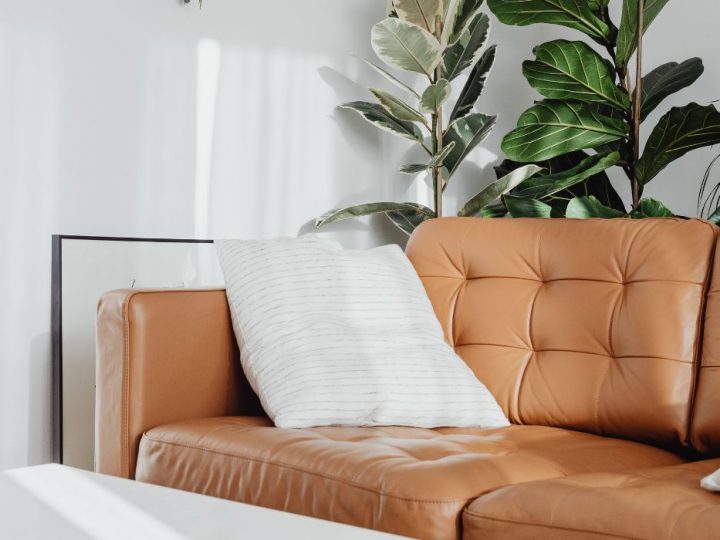WHAT IS MINIMALISM AND A FEW THINGS IT’S NOT
Minimalism is a lifestyle that enables you to focus on what matters. In this article I’m sharing my thoughts on what is minimalism and a few things it’s not. I hope it encourages you to approach minimalism with an open mind and explore it for yourself if you’d like to!
CONTENTS
In the following article I’ve covered some of the different topics and common questions about minimalism and the minimalist lifestyle. I’ll update this article regularly so be sure to visit back or bookmark it for future reference!
Here’s what we’ll cover:
- What is minimalism and the minimalist lifestyle?
- The definition of minimalism and finding your own version
- Different degrees of minimalism
- Myths about minimalism and what minimalism is not
- Practical examples of minimalist living
- The benefits of minimalism
- How to get started with minimalism
- The relationship between decluttering and minimalism
- Minimalist decluttering tips
- Minimalist lifestyle tips and how minimalism impacts life in other ways
- Minimalist wardrobe tips
- The minimalist mindset
- What are the difficulties of minimalist living?
- Minimalism and intentional living
- Resources on minimalist living
1. WHAT IS MINIMALISM AND THE MINIMALIST LIFESTYLE?
Minimalism is a design aesthetic but it’s also a lifestyle choice that’s been growing in popularity. For me, minimalism is about living simply and intentionally. It’s about choosing less stuff and more life, prioritising experiences and memories over physical clutter and being mindful of what I let into my home and life – in all its shapes and forms.
Perhaps minimalism and the minimalist lifestyle means prioritising what matters to you in a busy modern world? A world that’s shouting for your time, money, energy and attention and doing much of that prioritisation for you.
“We go on multiplying our conveniences only to multiply our cares. We increase our possessions only to the enlargement of our anxieties.”
Anna C. Brackett
I’ve been exploring simplifying my life through minimalism for nearly 10 years and over that time I’ve learnt so many things about myself, what I want from life and, just as importantly, what I don’t want.
Far from just being about what my home looks like or how many pairs of shoes I own, minimalism has encouraged me to look at my life from a different perspective and really define what matters. As it turned out, although many minimalists (including myself) talk about decluttering, minimalism is so much more than just getting rid of stuff.
In this article, I’d like to chat more about the minimalist life. If you’ve been searching for a definition to the question ‘What is minimalism?’, I’ll be trying to explain my interpretation of the minimalist lifestyle.
It’s a life that’s full in so many ways but without clutter to hold you back and pull you away from what matters. But, one of the ways I’d like to explain it in this article is actually by explaining what I don’t think it is!
2. THE DEFINITION OF MINIMALISM AND FINDING YOUR OWN VERSION
Whenever I’ve been asked for a single definition of minimalism, I always quote Joshua Becker. His website, becomingminimalist.com, inspired me to start my own minimalist journey and continues to inspire me today.
Joshua defines minimalism as…
“Minimalism is the intentional promotion of the things we most value and the removal of anything that distracts us from it.”
Whilst this is still the best definition I’ve ever come across about minimalism (notably because it doesn’t refer to just our physical clutter), it also highlights that minimalism is about as uniquely different from person to person as I am to you.
Although I’m sure that many of us would prioritise family, friends, health, happiness and contentment, I think there are plenty of other things that I value as well. And the same for you. It’s the combination of things that we give most value to that make up our lives and this complete picture varies from one person to the next.
This means that how you define and interpret minimalism is also different. It’s about finding your own version of minimalism that works for you.
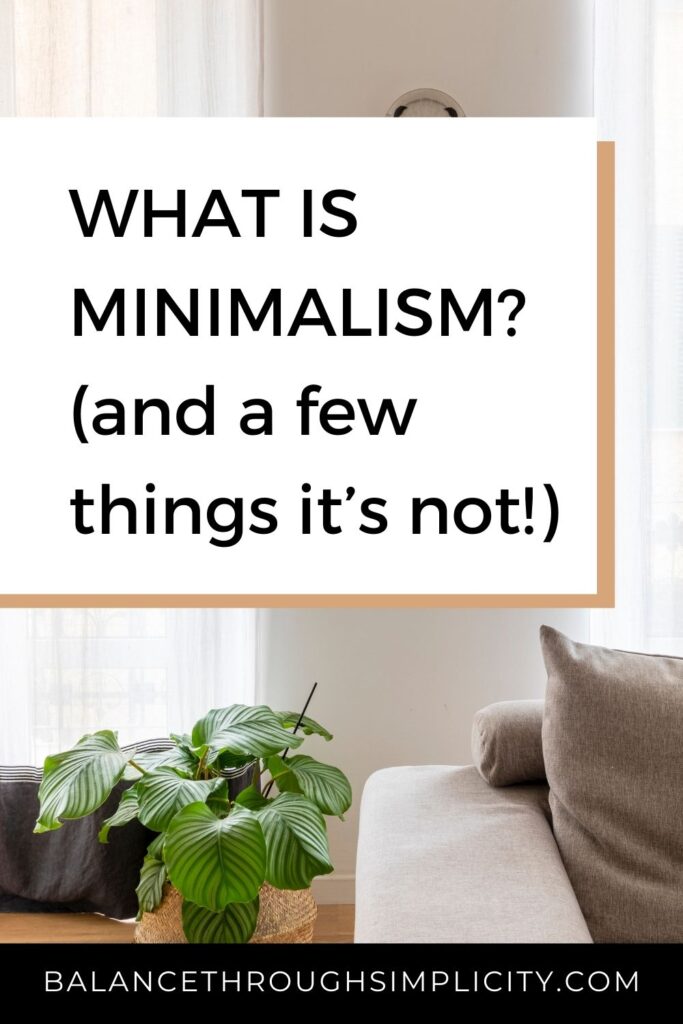
3. DIFFERENT DEGREES OF MINIMALISM
In finding your own version of minimalism you might:
- Start to declutter your home, clear your schedule, brain dump your thoughts, streamline your finances, overhaul your eating habits and fitness regime.
- You might delete unwanted emails, donate unread books, give away some toys your child has outgrown.
- You could even shop less, pull away from relationships that don’t support you, save more money or clear any debt.
You could do any or all of these things but you could also be more extreme.
- You might reduce your closet to a certain number of items, get rid of most of your furniture, throw out the TV, remove all the artwork from your walls.
Minimalism is a mindset shift that encourages you to re-evaluate what you have in your life and why you have it. But how you apply that depends on you. Think of minimalism as a spectrum. You can be as extreme (or not) as you like but the choice is yours.
You can still live according to Joshua Becker’s definition of minimalism and call yourself a minimalist, even if you have bookshelves of books or a few too many pairs of shoes in your closet!
4. MYTHS ABOUT MINIMALISM: WHAT MINIMALISM IS NOT
Another way of explaining what minimalism is, is to give you a few examples of what minimalism is NOT. Sometimes it’s easier to understand what something is by knowing what it isn’t. When it comes to minimalism, I think this is particularly helpful as there are so many myths and misconceptions about minimalism and what you have to DO or BE to be considered a minimalist.
a) Minimalism is not just about your stuff
First and foremost, minimalism is not just about your stuff! It is partly, but the guiding principles of intentionality, purpose and focusing on what matters in every aspect of your life goes way beyond the stuff that trips you up as you walk through your home or the piles of old magazines wedged under your bed.
Minimalism can benefit your self-care, your family finances, your goal-setting, your choice of career, your use of social media and way more besides!
b) Minimalism means you’ll never buy anything new
Plenty of minimalists like shopping and enjoy swapping the old for the new. There’s nothing wrong with shopping as long as it’s mindful and intentional. Instead of shopping for the sake of it, or because you’re bored or you subconsciously think that having more stuff will make you more happy, minimalists take a different approach. In general, they make wiser, more patient purchases that add value to their lives, not just stuff to their cupboards!
Read more about minimalism and shopping and how to shop with intention.
c) Minimalism is for people without kids
Children certainly bring chaos and clutter to our lives but I found that simplifying my life through minimalism made my motherhood so much easier! Not only was my home easier to keep clean and tidy, but my kids benefitted from having fewer toys, less distractions and overwhelming choice and more space to play. They became much more creative and resourceful without toys doing all the playing for them and they looked after the toys they did have so much better!
Read more about minimalism and motherhood, how to declutter toys or some different ways your kids can benefit from fewer toys.
d) Minimalism means you have to throw out all your stuff
Minimalists tend to own less stuff. They’ve often decluttered their homes and then realised that home and life is better when you have less clutter getting in the way. So, it’s a natural mindset shift to buy, want and own less stuff.
However, minimalism can look like whatever you want it to. So, if you’d like to keep your vintage record collection, have a garage full of tools that come in handy when you’re doing DIY, or you have a collection of ornamental elephants that you love to look at on your shelf (that’s me!), then that’s fine.
You can get rid of your stuff if you want to. Either in one go, or gradually over time, but how, what and when you do, is up to you! Minimalism isn’t about owning less for the sake of it. It’s about owning less because of the space, time and freedom it will give you instead.
Read this article on how to be a minimalist when you love stuff for some more tips!
“I’ve learned that minimalism isn’t about what you own, it’s about why you own it.”
Brian Gardner
e) A minimalist life is boring and empty
Minimalism does not make life boring and empty. In fact, I became minimalist BECAUSE my life felt boring and empty. I was fed up of managing my home instead of spending time with my family. I was frustrated at my days and life feeling like a treadmill that I was running fast to keep up with. I wanted more time, space, freedom, energy, money and enthusiasm so I could enjoy my home, my family and my life.
These were the reasons to become a minimalist that I’m reminded of every day when I appreciate life over stuff, memories and experiences over trying to stay on top of my laundry pile!
None of this happened instantly (you’ll read more about this in a moment) but reflecting back, my minimalist life is so much fuller and more rewarding and not in the least bit boring and empty!
f) Minimalism means you need white walls and no furniture
I love white walls and some blank space but that doesn’t mean my walls are empty! I have artwork and photos in strategic places but not so many that they all compete for my attention. I choose what’s on display in my home carefully, switch it around every now and then but I certainly have cushions, blankets and furniture – just not too much!
Minimalist homes can have colour, style, expression and individuality. I even wrote this article on minimalism for people who love colour instead of bare white walls! They don’t have to be white, empty or monochrome, unless that’s your design preference.
What minimalist homes do have in common is that they have less unwanted, unused and unloved stuff, they maximise use of space and are often calmer and more focused on those living in them.
Read more about how to create a minimalist family home.
g) Minimalism is instant
I didn’t wake up one day and think I’d like to become minimalist. It took me ages to feel that my life wasn’t working for me (or my family) and also ages to decide that decluttering and simplifying my home and life might be the solution.
From there it was about making small, but consistent steps to simplify every aspect of my life. I started with my clothes and then worked my way around the house. I used the same minimalist principles to declutter my schedule and be less busy, to simplify my eating habits, finances and find ways to stress less and enjoy life more.
None of this happened overnight. Minimalism was a slow, steady lifestyle shift where I made a conscious effort to make time, space and freedom for the things that really mattered to me in life.
If I’d woken up one morning and I said I was going to be a minimalist, I wouldn’t have known what I was doing, how to do it or why. I simplified my life over the long-term and this is how I found the benefits of minimalism to be so profound. I really understand what minimalism means to me.
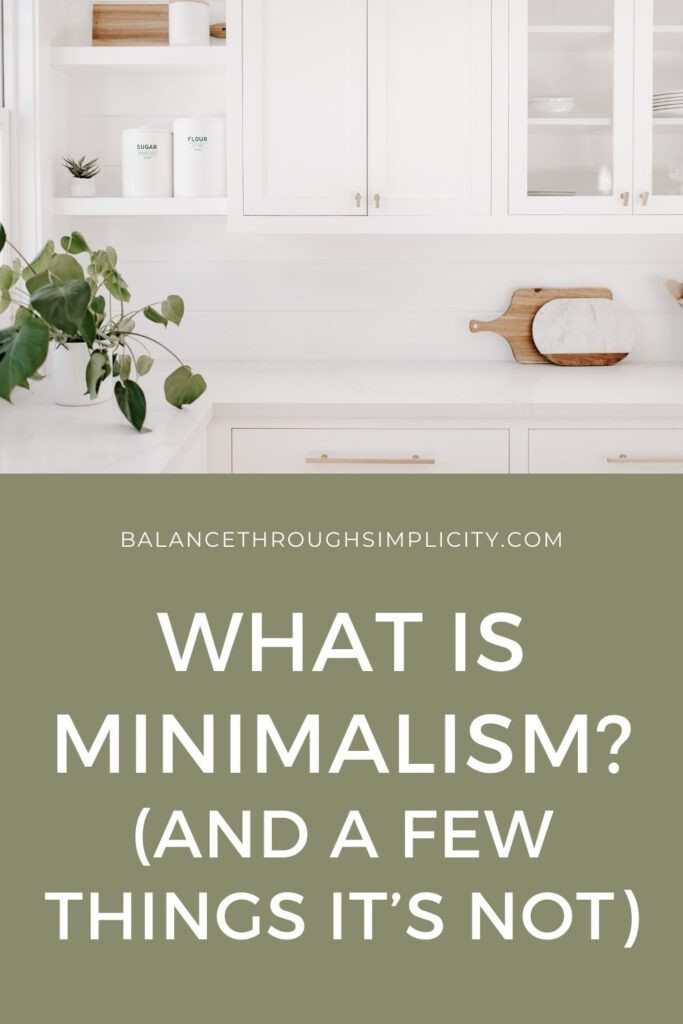
5. PRACTICAL EXAMPLES OF MINIMALISM AND MINIMALIST LIVING
Many people begin their minimalist journey by decluttering their homes. Clearing clutter gives you more physical space, less to tidy and clean and your home is clearer, calmer and more peaceful.
Further reading: How to declutter your home and life – a complete guide.
After experiencing the benefits from this, many people go on to declutter other aspects of their life, including self-care, finances, goals, career, calendar, work, relationships and so on.
For example you could…
- Look at your diary – Clear any appointments and commitments that you don’t have to do. Create free time or more time for what you want to do instead. There’s a wonderful relationship between minimalism and time management.
- Assess your finances – Decide whether you’re spending money on things that are important to you. If not, take steps to cut your spending, avoid those impulse buys, shop more intentionally and use minimalism to help you save money and spend more wisely.
- Monitor your social media consumption – Are you mindful about your use of social media or do you get sucked into the trap of perfect Instagram feeds and unhealthy comparison?
- Review your priorities – Is it to buy a bigger house, better car or a designer wardrobe? Or is it to have fun with your kids, challenge yourself with a new job or train to rock-climb and travel the world with your exciting new hobby? Align your life to follow your priorities.
A minimalist lifestyle isn’t just about clearing physical stuff. It’s about questioning what else clutters your life and making daily decisions to keep the clutter out so you have more room for what matters. After all, there are many different types of clutter and we’re all affected by that clutter in different ways.
6. THE BENEFITS OF MINIMALISM
Now we’ve looked at what minimalism is and also what minimalism isn’t, let’s have a look at some of the benefits of living a life with less.
As a mum of young kids, I first explored minimalism because I wanted to reduce the amount of stuff and clutter in my home. I was fed up of playing catch up, overwhelmed by the mess and forever moving, tidying and cleaning it. I wanted to enjoy my kids rather than being frazzled by them! It turned out that minimalism and motherhood were a great match!
Over the years, my minimalist lifestyle has turned out to bring so many more benefits than what began as a simple declutter.
I have more time, energy, freedom and better, stronger relationships. I also have less stress, spend less time cleaning, less debt and, importantly, a clearer vision of what I want out of life and how I’m going to achieve it. I can be truly present for the life I have now instead of managing the stuff I was hoping my life would create.
A minimalist lifestyle means a fuller life for me, just with less stuff. I have more of the things that I value and less of the things that I don’t. As a minimalist and introvert, I value peace, quiet and self-reflection and simplicity allows me to seek that out, as and when I need, to feel recharged and ready for the world again! Putting it simply – less stuff, more life.
Here are some of the other unexpected and life-changing benefits of minimalism.
7. HOW TO GET STARTED WITH MINIMALISM
The key to enjoying the benefits of a minimalist lifestyle is to find a way of incorporating the values and principles of minimalism into your life in slow, steady steps. Throwing everything out, without understanding why, just won’t work in the long term.
Many minimalists start out with decluttering their homes. Decluttering is a useful way of clearing the clutter, creating time and space so you can lean into your next steps. It’s where you can see and feel the benefits of living with less.
From there, it’s a question of evaluating your life. Consider what’s important to you and what’s just getting in the way of that and then deal with it. This could be what’s in your schedule, your shopping habits, what you cook for dinner. It’s about changing your habits and being mindful of the decisions you make on a daily basis and where they lead.
Suggested reading:
- 3 Things to Try if You’re Not Sure Minimalism is For You
- How to Become A minimalist: 7 Ways To Start
8. THE RELATIONSHIP BETWEEN DECLUTTERING AND MINIMALISM
Decluttering is an important first step to becoming minimalist and the easiest way of seeing the greatest impact in a short space of time. But, as we’ve looked at, there’s so much more to minimalism than decluttering your home.
Thinking of it another way sometimes helps. It’s possible to declutter without being a minimalist but it’s not possible to be a minimalist without decluttering.
Suggested reading:
9. MINIMALIST DECLUTTERING TIPS
Minimalism is about getting rid of the excess and becoming minimalist often starts with decluttering our stuff.
Here are some helpful minimalist decluttering tips which may help make clearing your clutter a little easier:
- Declutter your mind so you can focus on what matters
- Declutter your schedule to create space in your diary and your day
- Declutter sentimental items which mean something special and find ways to create memories in other ways
- Declutter your clothes and make getting dressed each morning easier and more enjoyable
- Create a calm, minimalist family home where you all enjoy coming home to
- Declutter your bedroom to encourage a better night’s sleep
- How to declutter when you’re stuck or don’t have much time
- Establish daily habits to stay clutter-free at home
- Spend less time cleaning with these Minimalist household routines
- Clear your inbox with these ideas on how to get rid of your digital clutter
Decluttering is an important part of embracing the minimalist lifestyle. I hope these tips help you get started!
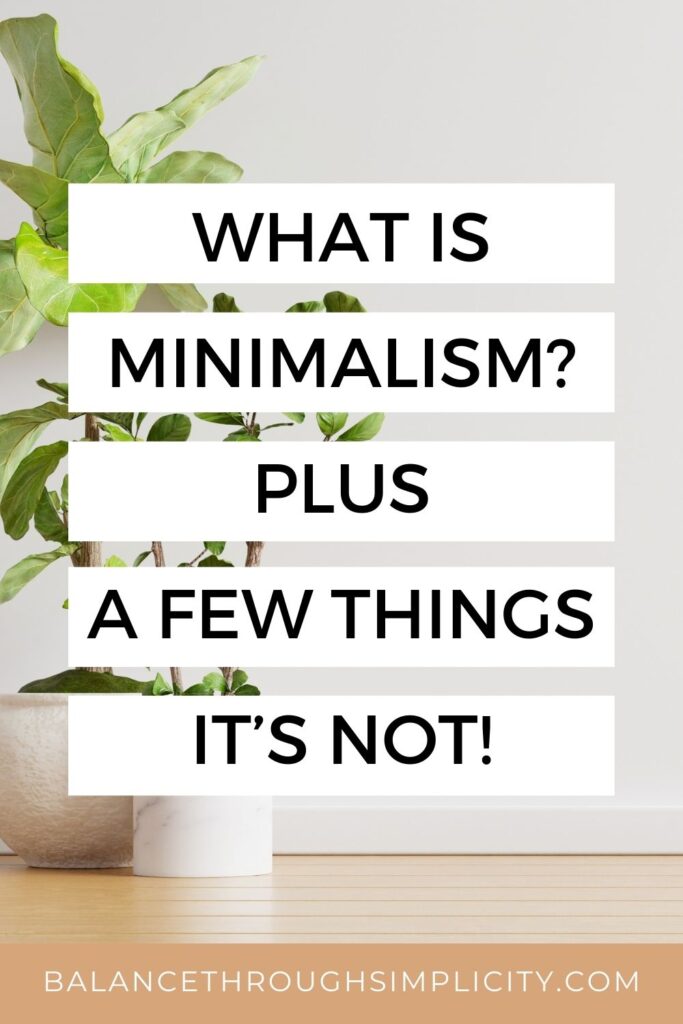
10. MINIMALIST LIFESTYLE TIPS AND HOW MINIMALISM IMPACTS LIFE IN OTHER WAYS
Minimalism is so much more than just getting rid of clutter and owning less. Minimalism can help us through life’s struggles, the ups and the downs, in different ways.
Remove the focus from stuff (less or more of it). Although being clutter-free is an essential component of the minimalist lifestyle, there is SO much more to it.
Minimalism can support us during other challenges and seasons of life because it removes the burden on our time, energy, finances and minds so that we can put our attention and energy where it’s needed most, or we want to spend it!
You might enjoy these minimalist lifestyle tips to help you embrace minimalism in different areas of your every day life.
Here are some other articles to help explain how minimalism can impact your life in other ways:
- Minimalism and Motherhood – How minimalist strategies and lifestyle can help mothers and parents in general embrace the challenges of raising kids whilst juggling the demands of everyday life. If you’re expected to ‘do it all’, minimalism can help you with that!
- Minimalism and time management – How the minimalist lifestyle can help us be more productive, efficient and manage our time and schedule better. There are many parallels between the intentionality of minimalism and the prioritisation of good time management. This article explains this in much more detail.
- Minimalism and Menopause – How the minimalist lifestyle can help women manage the difficulties of menopause and perimenopause. I know from personal experience about the physical and mental health challenges that mid-life can bring, especially in a season of life where we’re often looking after kids and aging parents, whilst holding down jobs. It’s a busy time and our bodies and brains don’t always help us! This article explains how minimalism can support you at this time.
- Minimalist Goal-Setting – Identify your priorities and define what’s important to you so you can set goals that really align with what matters to you and your life.
- Minimalist Morning Routine Tips – Stop trying to clutter your mornings with things you feel you ‘should’ be doing. Start the day with your own intentional morning routine. This article isn’t about stuffing your mornings full of lots of tasks and to do’s. It’s about supporting your body and mind to have the best day possible.
- Minimalism and ADHD – How the minimalist lifestyle helps with ADHD (Attention Deficit Hyperactivity Disorder). This is an interesting article written by a reader who shares her experience of minimalism alongside the challenges of ADHD.
- How Minimalism Benefits The Environment – Minimalism isn’t just about creating time, space and freedom to make your life easier and more fulfilling. Minimalism can help the planet too.
11. MINIMALIST WARDROBES
One of the most fun, but effective ways to bring minimalist living into your own life could be with your clothes.
Simplifying my clothes and exploring a minimalist wardrobe, maybe even a capsule wardrobe, was a game-changer for me in my rushed mornings with work and kids. It was one of my first decluttering projects and how I first got hooked on the benefits of minimalism!
Here are some resources you might find helpful to build your own minimalist wardrobe:
- 14 Amazing Benefits of a Capsule Wardrobe
- 12 Capsule Wardrobe Tips: A Simple Wardrobe Made Easy
- How to Stop Buying Clothes You Don’t Need
- How to be Ruthless When Decluttering Clothes
- Which Clothes to Declutter? Simple Questions to Help You Decide
- How a Personal Daily Uniform Can Simplify Your Life (+ Free Checklist)
- How to Purge Your Closet Quickly
12. THE MINIMALIST MINDSET
To understand and experience the benefits of minimalism and make it sustainable over the longer term, you need to change the way you think about the stuff in your life.
“The secret of happiness, you see, is not found in seeking more, but in developing the capacity to enjoy less.”
Socrates
Ask yourself, for example, how you’re going to guard against the clutter trying to creep back in? How will you resist temptation in the shops when you spot something on offer but that you can’t afford?
A minimalist mindset means being aware of clutter in all its forms. Not just your physical stuff but diary appointments, difficult relationships, negative thought patterns, unhealthy habits and anything else that fills your physical, emotional and psychological space without adding value in some way.
Suggested reading:
- How to Think Like a Minimalist
- How to Find Simplicity in Life (5 powerful tips to clear your clutter and live intentionally)
- Does Minimalism Make you Happier? – a personal perspective
13. WHAT ARE THE DIFFICULTIES OF MINIMALIST LIVING?
I’d be lying if I said that minimalist living was always easy. It comes more naturally to some people than others. For example, I’m ultra-organised and prefer simple over plain any day so exploring how to declutter my home and my life was relatively easy once I’d worked out my strategy. But many people find it difficult in the beginning.
Apart from the logistical side of decluttering your home, a minimalist lifestyle requires you to be intentional, deliberate and purposeful. Many of us find this difficult at first especially if we have no clear vision for what we want out of life or we’re looking for a quick-fix solution to a bigger problem. Maybe we want to try minimalism but we love our stuff, or our family’s not on board and we feel like the only minimalist in the home!
In my experience, the greatest benefit of becoming minimalist depends on:
- Understanding why you want to make changes
- Deciding what you hope to achieve by making those changes
- Having realistic expectations about how it will happen and when (it’s a long-term journey rather than a quick project you can tick off!)
- Being kind to yourself and keeping in mind the benefits even when friends and family don’t quite ‘get it’!
Suggested reading:
- Decluttering Tips for Hoarders
- How to Get Your Family on Board with Minimalism
- What Happens when Clutter Causes Tension at Home?
- Thoughts on Minimalism in Real Life
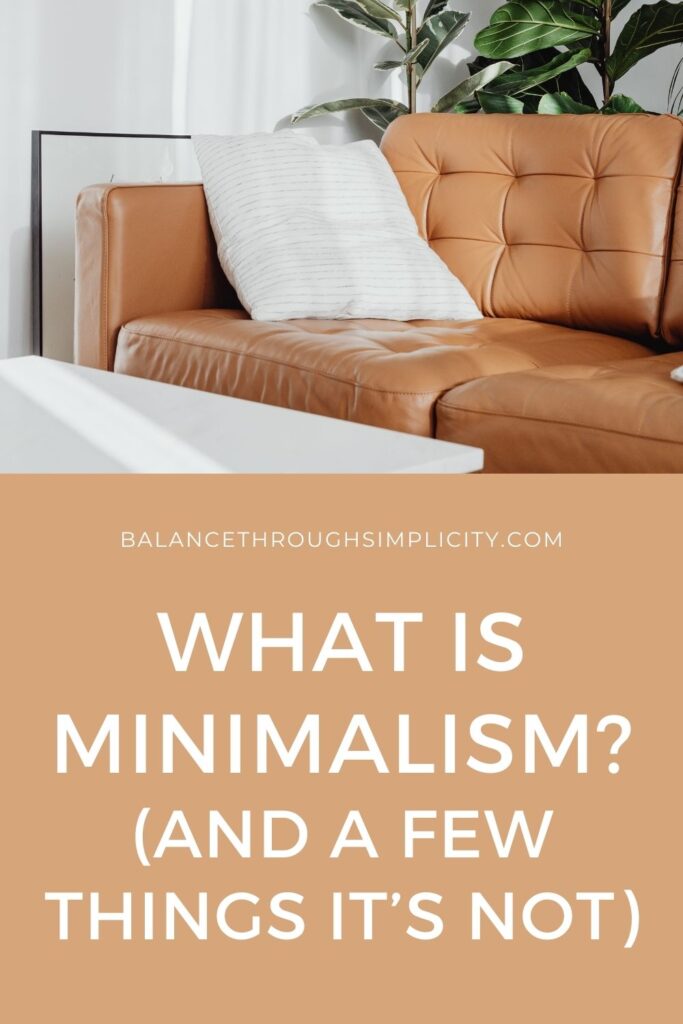
14. MINIMALISM AND INTENTIONAL LIVING
Deciding what’s important and letting go of the rest is a two-part process. It’s not a once-and-you’re-done project that you can tick of your To Do list.
The minimalist lifestyle is about defining your priorities and making every day choices that honour these. It’s about taking intentional decisions on what you want more of and less of in your life, for the long-term.
The Minimalist lifestyle goes hand in hand with intentional living and the art of creating a life that you love.
Minimalism is about choosing more for your life. It can broaden your horizons and give you space and scope for personal growth and getting the most out of life.
If you’d like to learn more about intentional living, I encourage you to explore these resources to get you started:
- What is Intentional Living? A beginner’s guide
- Your Intentional Life – a free mini course to help you find focus and direction in your own life
- 7 Ways to be Intentional With Your Time
- How to Create an Intentional Morning Routine
15. RESOURCES ON MINIMALIST LIVING
If you’d like to explore what a minimalist lifestyle could mean for you, here are some resources which you might find helpful:
- Simplify Your Life – an introduction to minimalist, intentional living with practical tips, challenges, guide and workbook to get started with today!
- Declutter Starter Kit – a free guide and workbook to help you understand the what, why and how of decluttering. Projects, tips and guidance to clear the clutter in your home and life.
- What’s so Great About Minimalism?
MINIMALISM AS A LIFESTYLE
I hope this article has given you some insight into what is minimalism and what it’s not. Minimalism, for me, has been one of the most impactful and exciting of journeys. It’s far removed from the boring, empty and stark life that it’s often portrayed.
There are many minimalists who like to experiment with having a limited number of items, trying a no-spend challenge, who enjoy living frugally or live in a tiny home. They’re all wonderful ways of exploring minimalism.
Sometimes I struggle with the label ‘minimalist’ because of how people perceive it, but I also sometimes like to call myself a minimalist because it reminds me of the guiding principles of minimalism – honouring what matters most and doing your best to keep the rest out! Here are some gentle reminders about minimalism in case you’d like a recap.
You might also enjoy these 9 lessons I’ve learned from minimalism over the nearly a decade since I began my own minimalist journey!
TRYING MINIMALISM FOR YOURSELF – YOUR NEXT STEP…
Minimalism isn’t about making you live with as little as possible. Instead it’s about curating space in your life for what’s important to you by mindfully removing anything that’s not.
If this sounds like something that could help you, take your first step today by clearing your clutter. Pop your details in the box below to get your free workbook and get started right now…
DON’T MISS OUT!
I’m Antonia and on this blog I share practical inspiration to simplify your home, time and life. Follow me on Instagram, Facebook and Pinterest! You can also subscribe to Balance Through Simplicity and receive regular simplicity tips straight to your inbox for free. Make sure you never miss an article plus you’ll get a copy of my free Declutter Starter Kit as a welcome gift!

